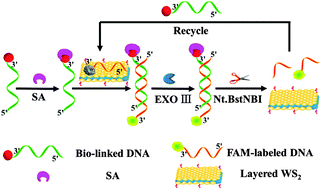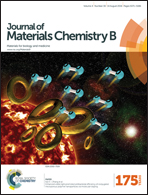A WS2 nanosheet-based nanosensor for the ultrasensitive detection of small molecule–protein interaction via terminal protection of small molecule-linked DNA and Nt.BstNBI-assisted recycling amplification†
Abstract
Small molecule–protein receptor interactions play vital regulatory roles in molecular diagnostics and therapeutics, chemical genetics, and drug development. However, the rapid, sensitive, low-cost, and selective detection of small molecule–protein receptor interaction remains a challenge. We report herein a new tungsten disulfide (WS2) nanosheet-based nanosensor for the ultrasensitive detection of small molecule–protein interaction via terminal protection of small molecule-linked DNA and Nt.BstNBI-assisted recycling amplification strategy. Taking the streptavidin (SA)–biotin system as a model, this assay exhibits high sensitivity with a detection limit of 5.3 pM. Besides a desirable sensitivity, the developed strategies also offer high selectivity, excellent reproducibility, low cost, and simplified operations, implying that these techniques may hold considerable potential for application in molecular diagnostics, biomedical research, genomic research as well as prediction of disease progression.


 Please wait while we load your content...
Please wait while we load your content...